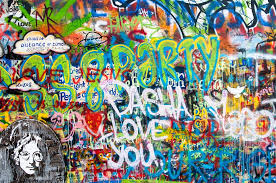Graffiti: Expressive form of art or public vandalism?!

January 23, 2017
In today’s modern society, people are creating new and artistic ways to express themselves to the public. Graffiti is a common form of expression and can be seen just about anywhere in the crowded streets of New York. While graffiti may just look like a colorful masterpiece, in reality it represents a purpose. However, while graffiti could be viewed as an expressive form of art, others perceive it as public vandalism. These people believe that graffiti artists should not be allowed to “express themselves” on personal property and should be punished for doing so. They believe that in fact graffiti is very destructive and causes a disturbance.
How do members of theNYC iSchool community feel about graffiti? Expressive form of art or public vandalism?!
Let’s begin with understanding what graffiti actually is…
According to English teacher Mr. Jones, “In my mind, I make a distinction between graffiti, which I would consider an act of vandalism meant to indicate a power shift in a public space, and street art, which to me is simply a repurposing of that same space. Graffiti, to me, is meant to challenge the social hierarchy of the status quo, while street art aims to establish a way of seeing the world. So I guess I define graffiti by naming both what it is and what it isn’t, and, since I’m not a graffiti artist myself, perhaps it isn’t up to me to define the term.”
Graffiti can be located in numerous places scattered across New York City, but most commonly graffiti is present in areas that are less densely populated and industrialized. Places with less office buildings and skyscrapers and more small buildings and open spaces, seem to be the places graffiti artists go to work on their individualized art.
“I notice graffiti most commonly in areas that aren’t so densely populated. Places with less offices and workplaces,” says Ms. Strassler, a history teacher here at the iSchool.
The purpose behind graffiti is often a mystery. Some graffiti artists claim it’s a form of expressing themselves and conveying their true emotions, while other graffiti artists do graffiti for the fun and excitement of it all. Discovering if graffiti really does serve a purpose in society is often a very debatable topic.
“People graffiti to voice their opinion on things, to prove a point, or to show their artwork to the public,” says freshman Lola Liotta.
“Artists choose to do graffiti to express a non-formal way of art,” says Lucas Scharankov, a freshmen at the NYC iSchool.
Graffiti expresses art. Graffiti challenges the powers that are existent in today’s society. It gives artists a voice and the opportunity to be heard.
“I think graffiti can give the people who do it a voice, a stage. It can perhaps serve as an outlet to their frustration. I think it seeks to create meaning where the artist believes there is none,” states Mr. Jones in a recent interview.
According to junior Shane Hemphill, he believes that graffiti expresses, “Freedom. Personality. Yourself.”
Graffiti is a form of art. Graffiti is a form of expressionism. Graffiti is the stage and the artist represents the star.

